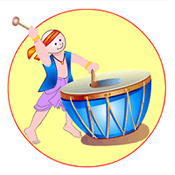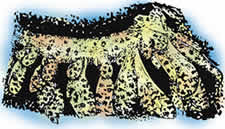
Dimdima
Online Children's Magazine from India

Dimdima
Online Children's Magazine from India

Sea slugs don't have shells to protect them from predators. Those that feed on corals protect themselves by taking on the colour of the corals.
Corals get their colour from the algae inside their body tissues. When a sea slug eats a coral, the algae is separated from the tissues in its stomach. The slug is able to take out the live algae from its stomach and put them over the long tentacles that sprout from its back. The algae, being the same colour as the coral, provide a perfect camouflage for the sea slug.
One species of sea slug, living in Australia's Great Barrier Reef, is able to stimulate the captive algae to proliferate. When the algae start growing, the slug develops extra tentacles along its flanks so that the algae can spread out and grow into large colonies.
The algae colonies hide the slug beautifully and at the same time provide it with sufficient food for sustenance and the slug does not have to depend on the coral any longer.
Last updated on :8/12/2005
EXPLORE MORE...
COMMENT ON THIS ARTICLE
Wants to share something related to this article? Please use the form below.
Dimdima is the Sanskrit word for ‘drumbeat’. In olden days, victory in battle was heralded by the beat of drums or any important news to be conveyed to the people used to be accompanied with drumbeats.
Bharatiya Vidya Bhavan
K. M Munshi Marg,
Chowpatty, Mumbai - 400 007
email : editor@dimdima.com
Bharatiya Vidya Bhavan
505, Sane Guruji Marg,
Tardeo, Mumbai - 400 034
email : promo@dimdima.com
Dimdima.com, the Children's Website of Bharatiya Vidya Bhavan launched in 2000 and came out with a Printed version of Dimdima Magazine in 2004. At present the Printed Version have more than 35,000 subscribers from India and Abroad.